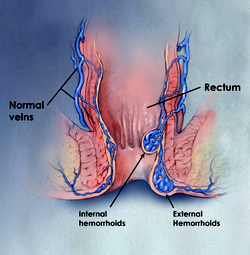 Hemorrhoids are one of the most common and nagging rectal disorders. Although troublesome, hemorrhoids are rarely serious and often clear up by themselves or with minimal treatment. Treatment typically is simple and effective and may include pain-free ligation or “banding” which can be done in an office setting. More serious cases may require surgery. People with hemorrhoids who work closely with their physician are usually assured a good outcome and relief from this common disorder.
Hemorrhoids are one of the most common and nagging rectal disorders. Although troublesome, hemorrhoids are rarely serious and often clear up by themselves or with minimal treatment. Treatment typically is simple and effective and may include pain-free ligation or “banding” which can be done in an office setting. More serious cases may require surgery. People with hemorrhoids who work closely with their physician are usually assured a good outcome and relief from this common disorder.
For more information about ligation or hemorrhoid banding, click here.
FAQs
Hemorrhoids are enlarged blood vessels or veins in the anal or rectal area. They can occur on the outside of the anus where they are felt as small bumps when wiping, or they may be located on the inside where they are usually painless.
Standing for long periods of time is a common cause of hemorrhoids, as blood above the rectum exerts pressure on the rectal and anal areas. Constipation, diarrhea, pregnancy, obesity and frequent straining when having a bowel movement can also be causes; however, some patients will have none of these conditions and still develop hemorrhoids.
Hemorrhoids can produce several uncomfortable, but non-serious, problems:
- Itching and irritation — External hemorrhoids can be itchy, especially if the area is moist and irritated.
- Bleeding — Hemorrhoids can ooze fresh red blood, whether located externally or internally. External hemorrhoids often cause dripping of blood from the anus while sitting on the toilet. The blood might also be seen in your underwear. Internal hemorrhoids that bleed may produce fresh blood in the stool.
- Thrombosis and pain — Severe pain may indicate a blood clot in the hemorrhoid and usually demands immediate medical attention.
Hemorrhoids may mask a more serious disorder such as rectal or colon cancer. Both can also cause rectal bleeding. Therefore, the proper diagnosis and treatment by a physician are important.
Treatment of hemorrhoids varies depending on where they are, what problems they are causing, and how serious they are. Often, the normal process of healing and time will clear hemorrhoids with little or no specific treatment. When hemorrhoids require treatment, the following general measures are recommended:
Basic Treatment
- Keep the anal area and hemorrhoids clean and dry. Be gentle when cleaning.
- Increase fiber and roughage in your diet and use bulking agents, such as Metamucil, Effersyllium, Konsyl, Citrucel, and Per Diem Fiber.
- Avoid straining when having a bowel movement.
- When thrombosis, pain, and tenderness occur, a 10 to 20 minute hot tub bath two to four times daily in a Sitz bath brings relief.
- Ligation or Banding – A common method of treating internal hemorrhoids is to tie off the base of the swollen vein. The blood circulation stops and the hemorrhoid falls off.
- Infrared Photocoagulation – An infrared light source can be used to coagulate internal hemorrhoidal veins.
Surgery is reserved for:
- An acute, painful clot (thrombosis) of hemorrhoids.
- Profusely or continuously bleeding hemorrhoids.
- Longstanding, irreversible, large hemorrhoids.
- When another treatment is unsuccessful.
Be sure to seek follow-up care with your physician.
Yes, you can help prevent them by:
- Eating plenty of fiber, bran, and roughage, or using a bulking agent to maintain regular, soft bowel movements.
- Not delaying or trying to prevent a bowel movement when the urge is present.
- Exercising, especially aerobically, to help produce more regular bowel movements.
- Drinking plenty of liquids and eating regularly scheduled meals.